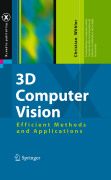
This book provides an introduction to the foundations of three-dimensional computer vision and describes recent contributions to the field. Geometric methods include linear and bundle adjustment based approaches to scene reconstruction and camera calibration, stereo vision, point cloud segmentation, and pose estimation of rigid, articulated, and flexible objects. Photometric techniques evaluate the intensity distribution in the image to infer three-dimensional scene structure, while real-aperture approaches exploit the behavior of the point spread function. It is shown how the integration of several methods increases reconstruction accuracy and robustness. Applications scenarios include industrial quality inspection, metrology, human-robot-interaction, and remote sensing. Overview of the current state of the art in the field of three-dimensionalcomputer vision Unified Description of photogrammetric and computer vision approaches In-depth presentation of three-dimensional scene analysis and surfacereconstruction, pose estimation, and motion analysis INDICE: Introduction.- Methods of three-dimensional computer vision.- Geometric approaches to the three-dimensional scene reconstruction.- Photometric approaches to the three-dimensional scene reconstruction.- Real-aperture approaches to three-dimensional scene reconstruction.- Integrated frameworks for three-dimensional scene reconstruction.- Application scenarios.- Applications to industrial quality inspection.- Applications to safe human-robot interaction.-Applications to lunar remote sensing.- Conclusion.- Bibliography.- Index.
- ISBN: 978-3-642-01731-5
- Editorial: Springer
- Encuadernacion: Cartoné
- Páginas: 300
- Fecha Publicación: 01/08/2009
- Nº Volúmenes: 1
- Idioma: Inglés
